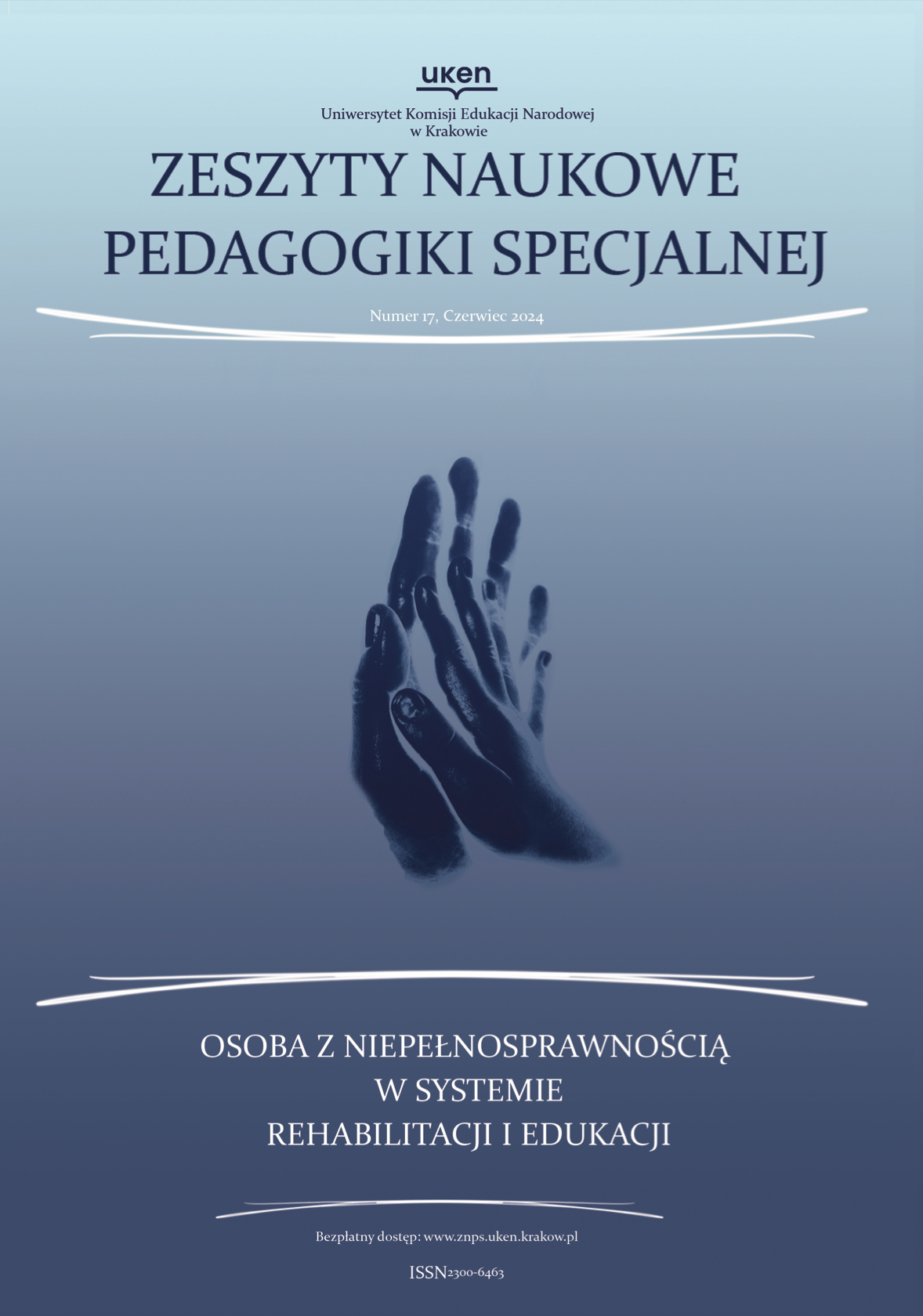Abstract
This article presents the topic of one of the language disorders that can occur in humans. The forms of aphasia, its essence and methods of treatment are discussed. Brain mechanisms that occur in patients with aphasic disorders are indicated, along with research on them. The course of speech and communication development of people with aphasia, the difficulties they have to face on a daily basis, as well as the types of language deficits and their course also play an important role in the article. Work methods were also discussed, including individual alternative methods of alternative and augmentative communication, including the MÓWik system, Makaton and the frequently used Pictograms. The next topic presented is the significant role of speech therapy and the form it can take – we distinguish individual or group therapy, which should be adapted to a specific individual. Topic of modernity and its possibilities of using it to improve and make more attractive the therapy of a person with aphasia was also presented. Computer-aided aids were mentioned, primarily TalksBac, Moss Talk Word, AfaSystem and Scene and Heard.
References
Helm-Estabrooks, N., Fitzpatrick, P. M., Barresi, B. (1981). Response of anagrammatic patient to a syntaxstimulation program for aphasia. The Journal of speech and heating disorders, 46(4), 422–427. https://doi.org/10.1044/jshd.4604.422
Herzyk, A. (2005). Wprowadzenie do neuropsychologii klinicznej. Warszawa: Wydawnictwo Scholar.
Hopper, T., Holland, A., Rewega, M. (2002). Conversational coaching: Treatmentoutcomes and futuredirections. Aphasiology, 16(7), 745-761.
Jastrzębowska, G., Kozołub, A. (1999). Afazja, dysfazja. W: T. Gałkowski, G. Jastrzębowska (red.), Logopedia. Pytania i odpowiedzi. Podręcznik akademicki. Opole: Wydawnictwo Uniwersytetu Opolskiego.
Jędryka, B. K. (2022). Wykorzystywanie wybranych materiałów do terapii afazji w dydaktyce języka polskiego jako obcego na niższych poziomach zaawansowania językowego. Poradnik Językowy, 10, 183-200.https://doi.org/10.33896/PorJ.2022.10.11
Katz, R. C. (2008). Efficacy of computerized aphasia treatment: Past research and future directions. Acta Neuropsychologica, 6(1), 17–26.
Litwin, M., Pietrzyk, I., Seniów, J. (2011). Grupowa terapia afazji. W: J. Gruba (red.), Wybrane problemy logopedyczne (s. 79–100). Gliwice: Wydawnictwo Fonem.eu.
Markuc, E. (2014). Wspomaganie niezależności komunikacyjnej dziecka niemówiącego w rodzinie za pomocą programu MÓWik. Annales Universitatis Paedagogicae Cracoviensis. Studia Paedagogica, III, 152, 119-127.
Maruszewski, M. (1966). Afazja. Zagadnienia teorii i terapii. Warszawa: Wydawnictwo PWN.
Mazurek, M. (2019). Afatyczne zaburzenia mowy jako wyzwanie dla starzejącego się społeczeństwa: przyczyny, diagnostyka i nowoczesne formy terapii. W: A. Borcuch, M. Knefel, A. Krzysztofek (red.), Zdrowy styl życia jako kapitał XXI wieku (s. 93-99). Kielce: Laboratorium Wiedzy Artur Borcuch.
Milewski, S., Przebinda, E., Kaczorowska-Bray, K., Michalik, M. (2022). Building Communicative Competence in People with Prelingual Speech Impairment Using the “Mówik” Speech Prosthesis. W: A. Arinushkina, I. Korobeynikov (red.), Education of Children with Special Needs (s. 361–370). Cham: Springer International Publishing.
Obszyńska-Litwiniec, A. (2019). Ocena przydatności komputerowego narzędzia wspomagania terapii logopedycznej w późnej fazie wczesnej rehabilitacji mowy u chorych z poudarową afazją. [Rozprawa doktorska, Warszawski Uniwersytet Medyczny].
Ostrowska, A., Halicka, D., Tarasiuk, J., Kułakowska, A. (2017). Zaburzenia funkcji językowych typu afazji u dzieci i osób dorosłych. W: A. Lankau, D. Kondzior, E. Krajewska-Kułak (red.), Sytuacje trudne w ochronie zdrowia. T.2(s. 18-40). Białystok: Uniwersytet Medyczny w Białymstoku.
Oszwa, U. (2019). Wczesna diagnoza dziecięcych trudności w liczeniu. Kraków: Oficyna Wydawnicza „Impuls”.
Prusiński, A. (2003). Neurologia praktyczna. Warszawa: Wydawnictwo Lekarskie PZWL.
Ryś, E., Szlachcic, K., Klimek, M., Galbarczyk, A. (2016). Programy komputerowe i aplikacje na elektroniczne urządzenia mobilne wspomagające terapię osób z afazją – przegląd literatury anglojęzycznej. Logopedia, 45, 291-304.
Seniów, J., Litwin, M. (2013). Afazja poudarowa. Neurologia po Dyplomie, 8(2), 46-51.
Shewan, C. M., Bandur, D. D. L. (1986). Treatment of aphasia: a language-orientedapproach. Taylor & Francis.
van de Sandt-Koenderman W. M. (2011). Aphasia rehabilitation and the role of computertechnology: can we keep up with modern times?. International journal of speech-language pathology, 13(1), 21–27. https://doi.org/10.3109/17549507.2010.502973
Waller, A., Dennis, F., Brodie, J., &Cairns, A. Y. (1998). Evaluating the use of TalksBac, a predictive Communications device for non eluent adults with aphasia. International journal of language&Communications disorders, 33(1), 45–70. https://doi.org/10.1080/136828298247929
Walsh, K. (1998). Neuropsychologia kliniczna. Wydawnictwo PWN.
Zawadzka, E., Domańska, Ł. (2007). Zasady organizacji procesu rehabilitacji neuropsychologicznej. Annales Universitatis Mariae Curie-Skłodowska Lublin-Polonia. Sectio J, XX, 123-135.
Zienkowicz, A. (2011). Istota rehabilitacji chorego z afazją – mowa a komunikacja. W: M. Orębska (red.), o utrudnieniach w porozumiewaniu się. Perspektywa języka i komunikacji. Poznań: Wydawnictwo Naukowe WNS UAM.


